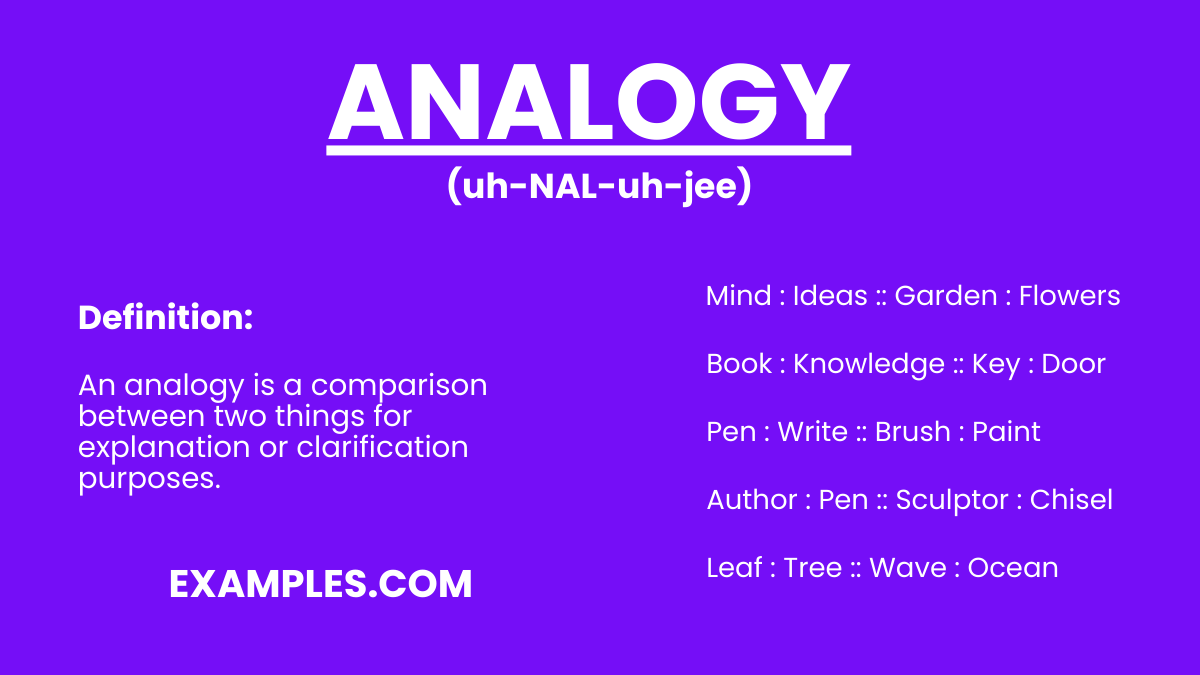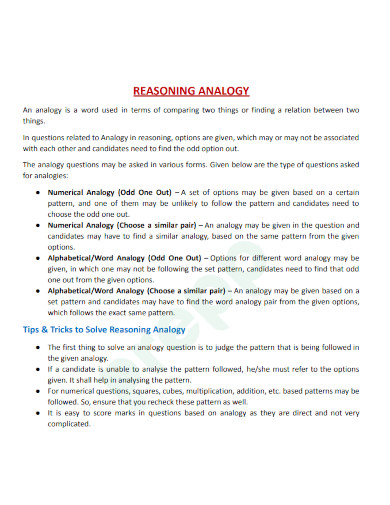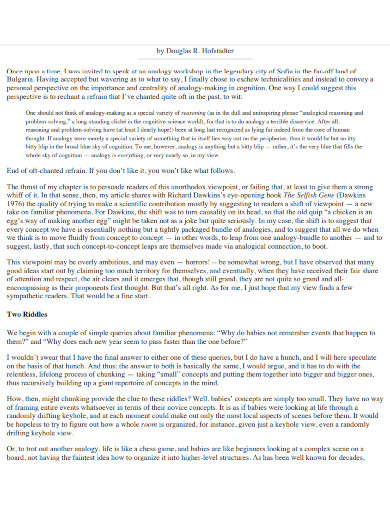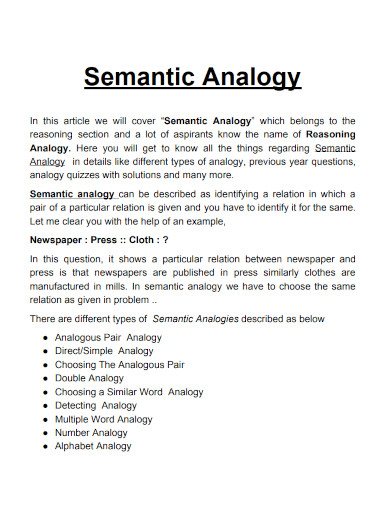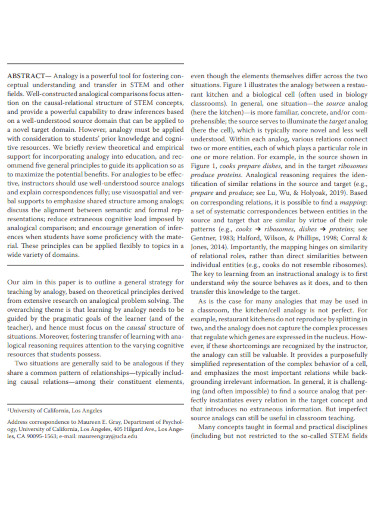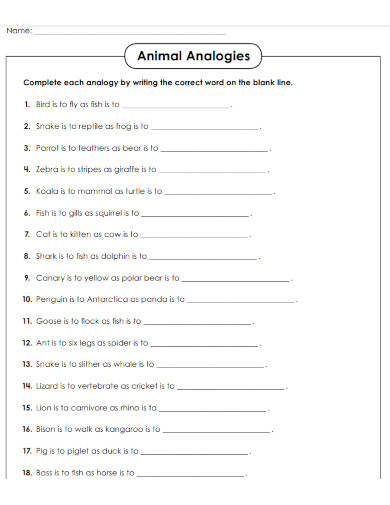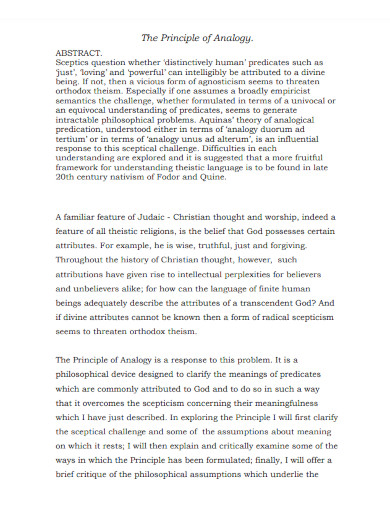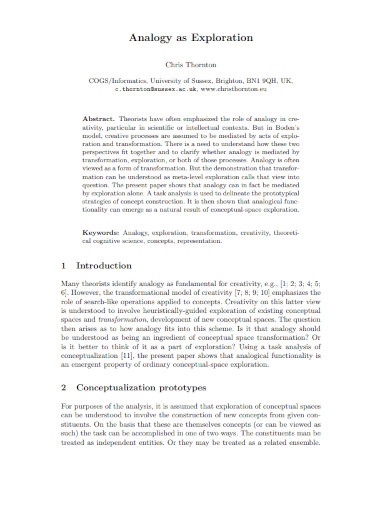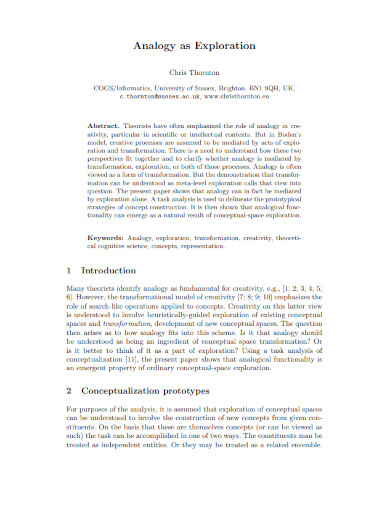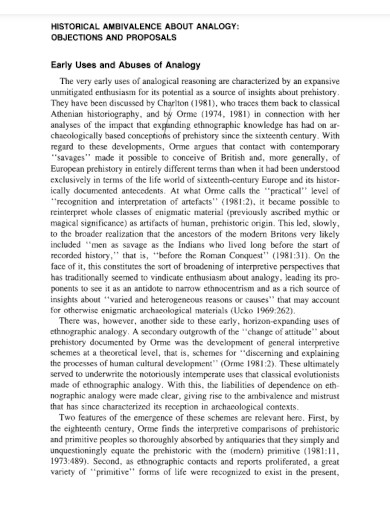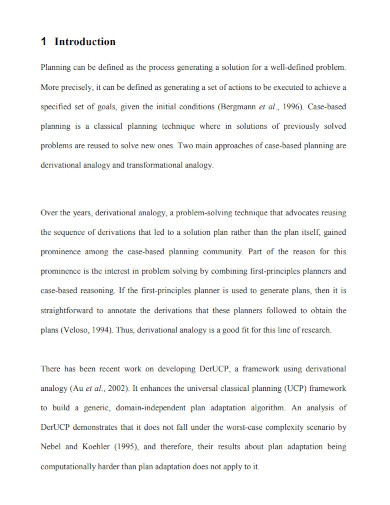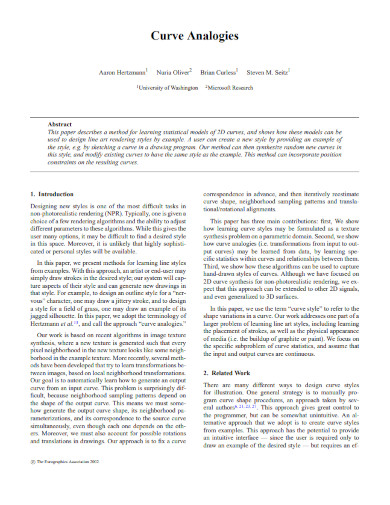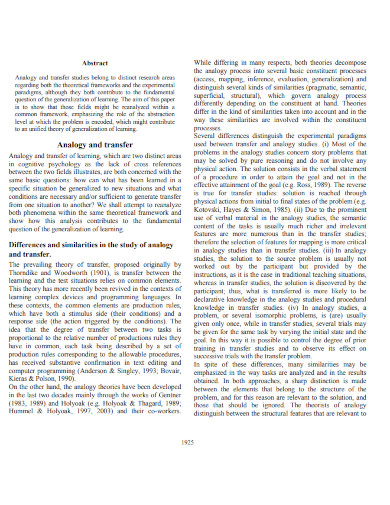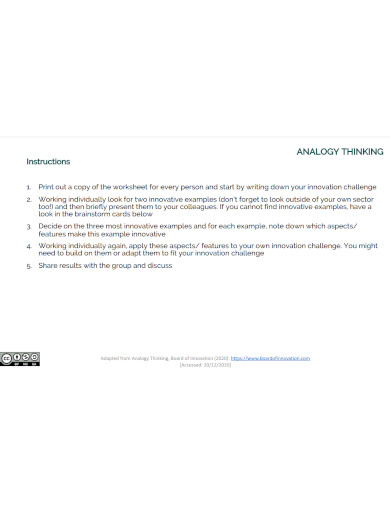Analogy
“He’s as strong as an ox” and “Navigating her emotions is like walking through a maze” are examples of analogies, a common method of comparison in the English language. Analogies are not only prevalent in literature and writing but also in everyday speech, serving as an effective tool for communication. They involve comparing two different things or ideas, which helps clarify or emphasize a point. This literary term, known as an analogy, encompasses various types of comparisons, making it a key element in both formal and informal expression.
Like any other literary analysis sample device, Analogy is used in enhancing the meaning of a composition and is also used in helping the readers in creating a visual image in their minds as well as relationships goals and connections when they would read something difficult or sensitive by comparing one thing to the other. Analogies are often used in thesis, essay writing, report writing, and even in speeches.
What is an Analogy? – Definition
An analogy is a comparison between two different things, intended to highlight some form of similarity. It’s a linguistic technique used to explain a new or complex idea by relating it to something familiar. Analogies are often used in teaching, writing, and speaking to make concepts easier to understand. They draw parallels that help people visualize and grasp the essence of the subjects being compared, thereby enhancing comprehension and retention.
Examples of Word Analogies
Analogies are crucial in language and thinking, comparing different concepts to enhance understanding. They are used in education to simplify complex ideas, in standardized tests to assess reasoning skills, and in job interviews to evaluate problem-solving abilities. Additionally, analogies enrich literature and daily communication. Examples like comparing pens to brushes or the sun to planets demonstrate how analogies illuminate various subjects, making them more accessible and relatable.
- Pen : Write :: Brush : Paint
- Relationship in First Pair: A pen is a tool used for writing.
- Application to Second Pair: Similarly, a brush is a tool, but it is used for painting.
- The analogy connects the function of each tool with its primary action.
- Sun : Solar System :: Planet : Galaxy
- Relationship in First Pair: The sun is a central part of our solar system.
- Application to Second Pair: In a broader scope, a planet is part of a galaxy, which is a larger system of celestial bodies.
- This analogy scales from a smaller celestial relationship (sun and solar system) to a larger one (planet and galaxy).
- Teacher : Classroom :: Captain : Ship
- Relationship in First Pair: A teacher is the guiding authority in a classroom.
- Application to Second Pair: Similarly, a captain is the guiding authority on a ship.
- The analogy compares the roles of authority and guidance in different settings.
- Clock : Time :: Thermometer : Temperature
- Relationship in First Pair: A clock is an instrument used to measure and indicate time.
- Application to Second Pair: In a similar vein, a thermometer is an instrument used to measure and indicate temperature.
- This analogy connects the function of measuring and indicating specific elements (time and temperature) with their respective instruments.
- Book : Library :: Art : Gallery
- Relationship in First Pair: A book is an individual item that is part of a collection in a library.
- Application to Second Pair: Similarly, a piece of art is an individual item that forms part of a collection in a gallery.
- The analogy shows the relationship of individual items (books, art) as components of larger collections (library, gallery).
- Leaf : Tree :: Wave : Ocean It compares the part-to-whole relationship of a leaf to a tree and a wave to an ocean.
- Author : Novel :: Composer : Symphony This analogy highlights the relationship between an author and their creation, a novel, to a composer and their creation, a symphony.
- Doctor : Hospital :: Teacher : School It parallels the role of a doctor in a hospital to that of a teacher in a school.
- Key : Piano :: String : Guitar This analogy compares the function of a key on a piano to a string on a guitar.
- Nurse : Healthcare :: Lawyer : Law Here, the analogy shows the relationship of a nurse to the field of healthcare and a lawyer to the field of law.
More Analogy Examples for You to Solve
- Owl : Night :: Eagle : _______
(Hint: Consider the time of day each bird is most active.) - Library : Books :: Museum : _______
(Hint: Think about what a museum houses.) - Novelist : Words :: Painter : _______
(Hint: Focus on the primary medium used by each artist.) - Teacher : Educate :: Chef : _______
(Hint: What is the primary action a chef performs?) - Fish : School :: Wolf : _______
(Hint: Consider the term for a group of these animals.) - Piano : Music :: Telescope : _______
(Hint: What does a telescope help us explore?) - Rain : Cloud :: Lava : _______
(Hint: Where does lava originate?) - Heart : Circulate :: Lungs : _______
(Hint: Think about the primary function of lungs.) - Leaf : Photosynthesis :: Root : _______
(Hint: Consider the main function of roots in a plant.) - Baker : Bakery :: Librarian : _______
(Hint: Where does a librarian work?) - Clock : Time :: Scale : _______
- Ocean : Saltwater :: Lake : _______
- Flower : Garden :: Book : _______
- Knife : Cut :: Screwdriver : _______
- Fire : Heat :: Snow : _______
- Poet : Poem :: Musician : _______
- Bird : Nest :: Bee : _______
- Tree : Oxygen :: Sun : _______
- Actor : Stage :: Athlete : _______
- Shoe : Foot :: Glove : _______
- Phone : Call :: Computer : _______
- Rain : Umbrella :: Sun : _______
- Leaf : Green :: Sky : _______
- Baker : Bread :: Winemaker : _______
- Painter : Portrait :: Writer : _______
- Doctor : Patient :: Teacher : _______
- Fisherman : Fish :: Miner : _______
- Keyboard : Type :: Mouse : _______
- Car : Garage :: Airplane : _______
- Map : Location :: Calendar : _______
Examples of Analogies for Critical Thinking
- Mind : Ideas :: Garden : Flowers
- Just as a garden is a space where flowers grow and flourish, the mind is a space where ideas are cultivated and developed. This analogy emphasizes the nurturing and growth aspects in both scenarios.
- Book : Knowledge :: Key : Door
- A book opens the door to knowledge, much like a key unlocks a door. This analogy highlights the unlocking and revealing nature of a book, providing access to new information and understanding.
- Telescope : Stars :: Microscope : Bacteria
- A telescope enables us to see distant stars, while a microscope allows us to view tiny bacteria. This analogy draws a parallel between the tools we use to explore vastly different scales of our universe, from the vast to the microscopic.
- Foundation : Building :: Roots : Tree
- Just as a foundation provides stability and support for a building, roots offer support and nourishment to a tree. This analogy compares the underlying support structures in architecture and nature.
- Words : Poetry :: Colors : Painting
- In poetry, words are woven together to create emotional and intellectual art, just as colors are blended in a painting to create a visual masterpiece. This analogy compares the elements of creation in different forms of art.
- Chef : Recipe :: Composer : Score
- A chef uses a recipe to create a dish, just like a composer uses a musical score to create a symphony.
- Author : Pen :: Sculptor : Chisel
- An author crafts stories with a pen as a sculptor shapes sculptures with a chisel.
- Fire : Warmth :: Ice : Coolness
- Fire is a source of warmth, as ice is a source of coolness.
- Clock : Time :: Thermometer : Temperature
- A clock measures time like a thermometer measures temperature.
- Tree : Oxygen :: Cloud : Rain
- Trees produce oxygen, and clouds produce rain.
More Examples for you to Solve:
- Helmet : Head :: Gloves : _______
(Hint: Consider what gloves protect.) - Sponge : Absorb :: Sieve : _______
(Hint: Think about what a sieve does with liquids.) - Caterpillar : Butterfly :: Tadpole : _______
(Hint: Consider the lifecycle transformation.) - Magnet : Attract :: Repellent : _______
(Hint: Think of the opposite action of attracting.) - Flashlight : Darkness :: Air Conditioner : _______
(Hint: What does an air conditioner alleviate?) - Furnace : Heat :: Refrigerator : _______
(Hint: Think about what a refrigerator preserves.) - Anchor : Ship :: Brakes : _______
(Hint: Consider what brakes do to a vehicle.) - Recipe : Dish :: Blueprint : _______
(Hint: What is created using a blueprint?) - Vaccine : Disease :: Fertilizer : _______
(Hint: Think about what fertilizer promotes.) - Lighthouse : Ships :: Traffic Light : _______
(Hint: Consider what traffic lights guide.) - Archive : Documents :: Museum : _______
- Rudder : Direction :: Engine : _______
- Thermometer : Temperature :: Barometer : _______
- Author : Story :: Composer : _______
- Nest : Bird :: Den : _______
- Broom : Sweep :: Hose : _______
- Window : Light :: Dam : _______
- Dew : Morning :: Frost : _______
- Key : Lock :: Code : _______
- Easel : Painter :: Anvil : _______
Analogy Examples in Sentence
- Life is like a box of chocolates; you never know what you’re going to get.
This analogy compares the unpredictability of life with the surprise of picking a chocolate from an assorted box. - The heart of a car is its engine.
This draws a parallel between the essential role of the heart in the human body and the engine in a vehicle. - A good book is a magic gateway into another world.
Here, the transformative power of reading is likened to a portal leading to new, undiscovered realms. - The classroom was a zoo.
This analogy suggests the noisy and chaotic nature of the classroom, similar to the lively environment of a zoo. - Her eyes were windows to her soul.
This sentence compares eyes to windows, implying that they reveal deep emotions or the essence of a person. - Time is a thief.
This analogy implies that time steals moments from our lives, much like a thief takes away possessions. - The computer in the modern age is like a pen in the past.
This draws a comparison between the role of computers today in communication and creation, and the role of the pen in earlier times. - The moon is a ghostly galleon tossed upon cloudy seas.
This vividly portrays the moon as a ghostly ship sailing across the sky, with clouds as its sea. - The world is a stage, and we are merely players.
This famous analogy from Shakespeare suggests that life is like a play, and everyone has a role to perform. - Watching the show was like walking through a dream.
This suggests the surreal, dream-like quality of the show, likened to the experience of walking through a dream.
Examples of Analogy in Literature
Analogy is a common literary device used by authors to draw comparisons between two different things, often to highlight a particular theme or idea. Here are some examples of analogy in literature:
- Shakespeare’s “As You Like It”: “All the world’s a stage, and all the men and women merely players.”
- This famous analogy compares the world to a stage and life to a play, suggesting that our lives are structured like a theatrical performance, with different roles and acts.
- George Orwell’s “Animal Farm”: The entire novel serves as an extended analogy for the Russian Revolution of 1917 and the early years of the Soviet Union.
- Orwell uses farm animals to represent historical figures and social classes, drawing parallels between the farm’s descent into tyranny and the history of Soviet communism.
- Harper Lee’s “To Kill a Mockingbird”: “The events in Maycomb County are described as ‘a disease, like the run of mumps.'”
- Here, the prejudice and racism in Maycomb are compared to a disease, suggesting they are both harmful and spread uncontrollably.
- Robert Frost’s “The Road Not Taken”: The poem’s roads are an analogy for the choices we make in life.
- The diverging paths symbolize life’s different options and directions, and the choice of path represents a decision that shapes one’s future.
- Homer’s “The Odyssey”: “I am a part of all that I have met.”
- In this analogy, experiences are likened to physical parts of a person, suggesting that they become integral to one’s identity.
Types of Analogy
- Literal Analogy: Compares two similar things or classes of things that have the same relationship. For example, “Just as a sword is the weapon of a warrior, a pen is the weapon of a writer.”
- Figurative Analogy: Involves a comparison between two things that are different in nature, often used to explain a concept or to persuade. For instance, comparing the mind to a computer.
- Relational Analogy: Focuses on the relationship between pairs of words. For example, “Hand is to glove as foot is to sock.” The relationship is about things that cover.
- Personal Analogy: Requires imagining oneself as an object or a situation. It’s often used in problem-solving to look at things from a different perspective.
- Predictive Analogy: Used to predict the outcome of some actions by comparing it to known outcomes in similar scenarios. For example, “If you overwater a plant, it dies; similarly, too much of anything, even a good thing, can be harmful.”
- Analogical Argument: Used in persuasive writing and speech, where an analogy is used as an argument or as a part of an argument.
- Negative Analogy: Focuses on comparing dissimilarities between two things. For example, “Arguing on the internet is unlike a sports competition; there are no clear winners.”
- Medical Analogy: Common in medical fields, where symptoms or conditions of a patient are compared to typical cases to diagnose or treat.
- Historical Analogy: Draws a comparison between historical events to explain or predict current events. For example, comparing modern political situations to historical ones.
- Mathematical Analogy: Involves comparing mathematical relationships, often used in teaching complex mathematical concepts.
How to Write an Analogy
- Identify the Core Idea or Concept: Begin by determining the main idea or concept you want to explain or enhance through the analogy.
- Find a Relatable Comparison: Choose a familiar or easily understandable object, situation, or concept that shares similarities or relationships with your core idea.
- Establish a Clear Relationship: Ensure that the relationship between the two entities in your analogy is clear and logical. The comparison should highlight the similarities or explain the concept effectively.
- Use Simple and Effective Language: The effectiveness of an analogy often lies in its simplicity. Use language that is easy to understand and avoids complexity.
- Be Consistent: Maintain consistency in the elements of your analogy. Mixing different metaphors or comparisons can lead to confusion.
- Test Your Analogy: Before finalizing, test your analogy to see if it makes the concept clearer and is understandable to your intended audience.
When to Use Analogy
- To Simplify Complex Ideas: Analogies are excellent for breaking down complex or abstract concepts into simpler, more relatable terms.
- In Teaching and Education: They are used to explain new or difficult subjects by relating them to something familiar to the students.
- To Persuade or Argue: In rhetoric and writing, analogies can make arguments more persuasive by drawing parallels that the audience can easily understand.
- To Enhance Writing: Writers often use analogies to add depth, creativity, and imagery to their writing, making it more engaging and vivid.
- In Problem-Solving: Analogies can help in seeing problems from a new perspective, leading to innovative solutions.
How Does Analogy Work
- By Establishing Relationships: Analogies work by drawing a parallel between two disparate entities, emphasizing their similarities in relation to each other.
- Through Familiarity and Understanding: They often use familiar concepts to explain unfamiliar ones, making new or complex information more digestible and easier to grasp.
- Creating Mental Images: Good analogies create vivid mental images, which can be more effective in communication than abstract concepts.
- Enhancing Memory and Retention: Because they often involve storytelling or imagery, analogies can be more memorable than straightforward explanations, aiding in better retention of the information.
- Building on Prior Knowledge: Analogies leverage the audience’s existing knowledge or experience, providing a foundation for understanding new information.
Analogies, when used effectively, can be powerful tools for communication, learning, and creativity, bridging gaps in understanding by connecting the unknown to the
25 Examples of Analogies
1. Life is Like a Race

2. Finding a Good Man is Like Finding a Needle in a Haystack

3. Just as a Sword is the Weapon of a Warrior, a Pen is the Weapon of a Writer

4. That’s as Useful as Rearranging Deck Chairs on the Titanic.
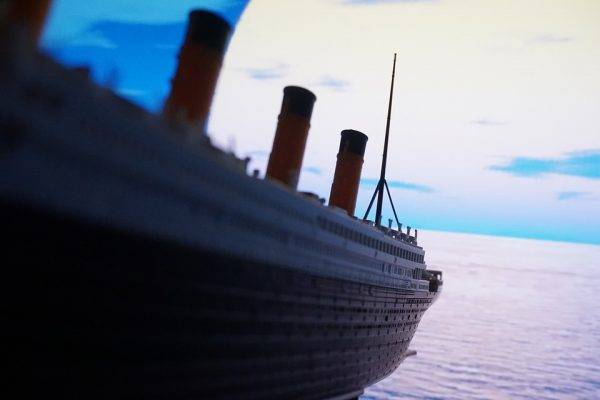
5. How a Doctor Diagnoses Diseases are Like How a Detective Investigates Crimes

6. Explaining a Joke is Like Dissecting a Frog

7. Just as a Caterpillar Comes out of its Cocoon, So we Must Come out of our Comfort Zone

8. A Movie is a Roller Coaster Ride of Emotions.

9. You are as Annoying as Nails on a Chalkboard.

10. Life is Like a Box of Chocolates – You Never Know What You’re Gonna Get!

11. Reasoning Analogy
12. Analogy as the Core of Cognition
13. Analogy by Similarity Example
14. Semantic Analogy Example
15. Teaching by Analogy Example
16. Animal Analogies Example
17. The Principle of Analogy
18. Analogy as Exploration
19. Science Analogy Example
20. Practice Analogy Questions
21. The Reaction Against Analogy
22. Transformational Analogy Example
23. Curve Analogies Template
24. Analogy and Transfer
25. Analogy in Thinking Example
What is an Analogy?
A figurative analogy is used when you compare two completely different ideas or things and use its similarities to give an explanation of things that are hard to understand or are too sensitive. Analogies are often used in thesis, essay writing, report writing, and even in speeches.
How to Write an Analogy
When you think of writing, you think of carefully selecting the things you want to write about. From the right words, phrases, structure, and sentences. All in order to please your target readers. It is the same as cooking or baking. You want to follow the right ingredients and the recipes. Writing is like cooking or baking. To get them to work together, you must also follow the tips listed below.
Step 1: Identify the Two or More Things You Want to Compare
To start is to identify two or more words or phrases you may want to compare. This is the first step to writing your analogy. You must also be careful with the analogy you are going to be using, if your audiences are children, you can use analogy for kids. The important thing is to be able to explain the idea or the concept.
Step 2: Do Your Research on the Similarities
In order for you to explain and understand the similarities between the words or phrases that you are using for analogy, you must first do your research about it. Simply writing two words together to compare is not enough. It is also important for you to understand what these two words mean and how similar are they in order for them to be compared.
Step 3: Make the Analogies
Make or create the analogies once you have figured out the similarities of the words you have written. If you have not, go back to the second step and continue until you found them. The analogy must be in a simple sentence or a simple statement. Avoid using technical jargon that defeats the purpose of the analogy.
Step 4: Give the Explanation of the Chosen Analogies
The last step is to give out the explanation of the chosen analogies. The explanation will help give the reader the idea of what they are reading and can grasp the information from the analogies. Provided the fact that these chosen analogies details and examples to back it.
FAQs
What is the difference with analogy, simile and metaphor?
More often than not, an analogy is sometimes mistaken with the other figures of speech examples, namely simile and metaphor, because these are used to seek relationships between concepts and things. The figurative language simile compares two objects that use comparison words such as ‘like’ and ‘as’ where the whole metaphor would compare two objects with the use of the said comparison words.
What are the elements of an analogy?
What you can expect in the elements of an analogy are as follows: the two or more concepts that need to be compared, the shared characteristics of these concepts, the differences of the concepts, the purpose, the clarification, and lastly the creativity.
What is the difference between analogy and idioms?
An analogy is a comparison of two or more things, topics or concepts that helps explain the topic. An idiom is a phrase that has a figurative language or meaning to it.
Analogy compares two completely different things and look for similarities between two things or concepts and it only focuses on that angle. The use and purpose of analogies may baffle any reader at first but once they would realize how analogies can help writers in making difficult and sensitive topics or things understandable, analogies might be used frequently.


